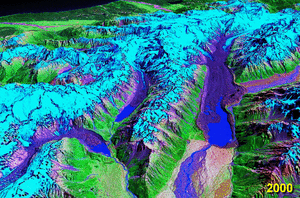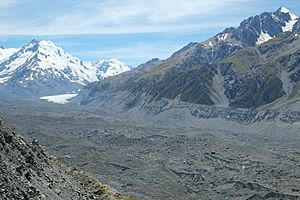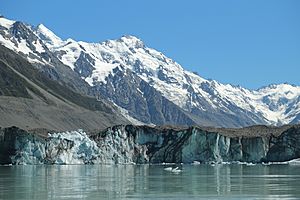Haupapa / Tasman Glacier facts for kids
Quick facts for kids Haupapa / Tasman Glacier |
|
|---|---|

Upper half of the Tasman Glacier
|
|
| Type | Mountain glacier |
| Location | New Zealand |
| Coordinates | 43°37′S 170°12′E / 43.617°S 170.200°E |
| Area | 101 km2 (39 sq mi) |
| Length | 23.5 km (14.6 mi) |
| Thickness | 600 m (2,000 ft) |
| Terminus | Lake Tasman |
| Status | Retreating |
Haupapa / Tasman Glacier is the biggest glacier in New Zealand. It is one of many large glaciers that flow from the Southern Alps in New Zealand's South Island. These glaciers move south and east towards the Mackenzie Basin.
Contents
What is the Tasman Glacier Like?
The Tasman Glacier is New Zealand's longest glacier. It is about 23.5 kilometres (14.6 mi) long. Even though it has shrunk a lot since the 1990s, it is still the longest. This huge ice river can be as wide as 4 kilometres (2.5 mi) and as thick as 600 metres (2,000 ft). It is completely inside the Aoraki / Mount Cook National Park.
Where Does the Glacier Start and Flow?
The glacier covers an area of 101 square kilometres (39 sq mi). It starts high up at 3,000 metres (9,800 ft) above sea level. In winter and spring, up to 50 metres (160 ft) of snow can fall on its upper parts. After the summer melt, about 7 metres (23 ft) of snow might still be left at the high-altitude glacier head.
The Tasman Glacier flows southwest from Hochstetter Dome and Mount Elie De Beaumont. It moves along the southern side of the Minarets peak. Then it goes south along the eastern side of New Zealand's two highest mountains, Mount Tasman and Aoraki / Mount Cook.
How Does the Glacier Look?
The top parts of the glacier are covered in snow. But as the glacier moves, it picks up rocks. These rocks become visible on the lower parts of the glacier. The bottom of the glacier is completely covered in these rocks. This rock layer acts like a blanket, helping to protect the ice from the sun. This slows down how fast the ice melts.
Several smaller glaciers join the Tasman Glacier in its lower parts. These are the Rudolf Glacier, Forrest Ross Glacier, Kaufmann Glacier, Haast Glacier, Hochstetter Glacier, and Ball Glacier.
Where Does the Meltwater Go?
The meltwater from the Murchison Glacier flows into the Tasman Glacier's terminal lake. This lake is called Tasman Lake. The water from Tasman Lake then flows into the Tasman River. This river joins the Hooker River, which carries water from the Hooker and Mueller Glaciers. The Tasman River has a "braided" look, meaning it splits into many small channels. It flows south into Lake Pukaki. Eventually, all this water flows into the Waitaki River and then into the Pacific Ocean, north of Oamaru.
Why is the Tasman Glacier Shrinking?
For most of the 20th century, the Tasman Glacier stayed about 28 km (17 mi) long. But in the 1990s, it started to melt very quickly. This is called a period of rapid retreat.

Between 2000 and 2008, the end of the glacier moved back 3.7 kilometres (2.3 mi). Since the 1990s, the glacier has been shrinking by about 180 metres (590 ft) each year on average. Now, it is shrinking even faster, between 477 to 822 metres (1,565 to 2,697 ft) every year. Scientists think the Tasman Glacier will eventually disappear. They estimate that Tasman Lake will reach its biggest size in 10 to 19 years. In 1973, there was no Tasman Lake. By 2008, it was 7 kilometres (4.3 mi) long, 2 kilometres (1.2 mi) wide, and 245 metres (804 ft) deep.
What Caused the Big Ice Break?
On February 22, 2011, a huge piece of ice broke off the glacier. This event might have been caused or helped by the 2011 Christchurch earthquake. About 30 to 40 million metric tons of ice fell into Tasman Lake. Boats on the lake were hit by tsunami waves up to 3.5 metres (11 ft) high. Similar events in the past have happened when there was a lot of water under the glacier or when the lake level was high after heavy rain.
How Can People Visit the Glacier?
Tourism at the Tasman Glacier has a long history. Heli-skiing tours, where people are flown to the top of the glacier to ski down, have been offered since the early 1970s. The nearby Ball Glacier was also popular for skiing, even hosting national championships in the 1930s. However, it has shrunk too much to be safe for skiing now.
The Tasman Glacier's big ice loss has also changed tourism. More cracks, called crevasses, are now open and not filled with snow. This means guided tours must avoid these areas. The heli-skiing season is now limited to July, August, and September.
Exploring Tasman Lake
Tasman Lake, which is fed by the glacier's meltwater, is a popular spot for boat tours. People enjoy seeing the icebergs that often float in the lake. For safety, boats are not allowed closer than 1.5 km (0.9 mi) to the 50 m (160 ft) tall ice face of the Tasman Glacier.
The Ball Shelter Track is a walking path that goes along the western side of the glacier. For about 6 kilometers, a tall wall of rocks, called a moraine wall, separates the path from Tasman Lake. After that, the path climbs higher, and you can see the rock-covered lower Tasman Glacier. In this area, the glacier in the valley between the moraine walls is about 2.5 km (1.6 mi) wide.
See also
 In Spanish: Glaciar Tasman para niños
In Spanish: Glaciar Tasman para niños



